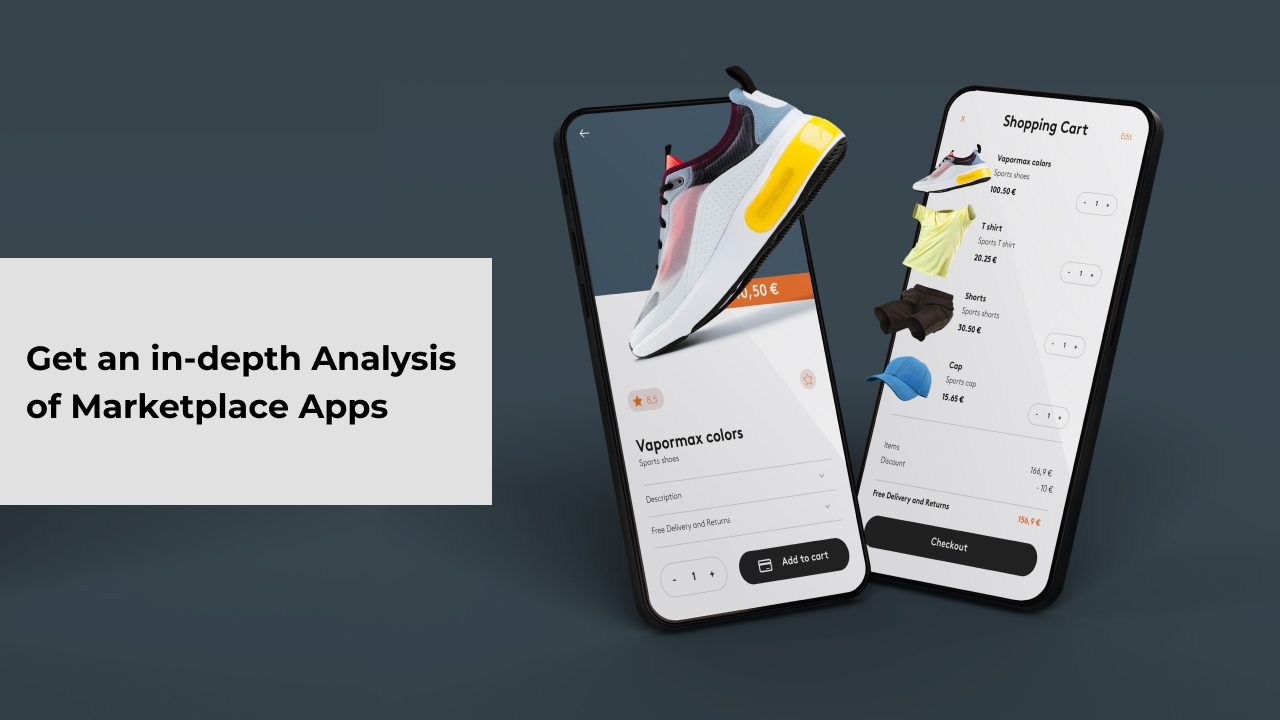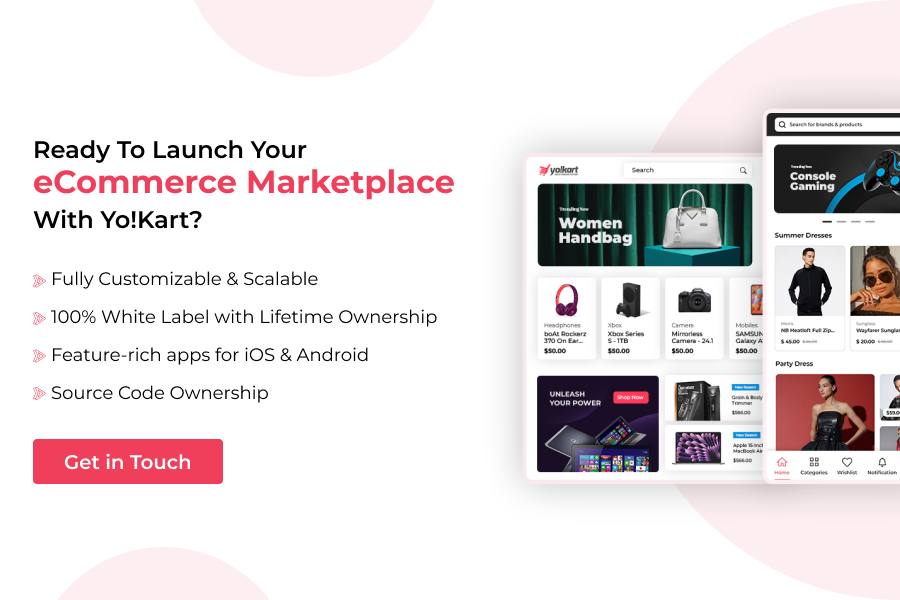Last Updated 28th July, 2025
Marketplace apps are all around us. They are revolutionizing and transforming businesses across industries, from fashion to grocery delivery to the pharma sector. As mobile commerce continues to dominate, building a marketplace app has become a strategic necessity. For consumers, heading to the app store to find a new app that solves their needs has become second nature. With the rapid growth of mobile app development and the increasing demand for online-first shopping, businesses are increasingly looking to create a marketplace app to stay competitive.
So what exactly is an online marketplace?
At a fundamental level, think Amazon. A marketplace platform that you launch with no inventory of yourself to sell. You simply invite third-party sellers on the platform to sell to buyers ― and manage eCommerce operations by assigning Admin(s) to the marketplace.
Given the surge in competition and the rise of mobile commerce, it’s crucial to build a marketplace app that is robust, scalable, and user-friendly. But how do you create a marketplace app that truly delivers value? In this guide, we’ll walk you through the essentials of marketplace app development, from types to key features and the complete steps to create a marketplace app in 2025.
Table of Contents
- What is a Marketplace App?
- Benefits of Building a Marketplace App in 2025
- How Marketplace App Development Transformed Leading Multivendor eCommerce Businesses?
- Popular Niches to Build a Marketplace App
- What are the Types of Marketplace Apps?
- Top 15 Features to Consider While Building a Marketplace App
- Steps to Create a Marketplace App
- How Much Does it Cost to Create a Marketplace App?
- Get Readymade Mobile Apps with Yo!Kart
- Conclusion
- FAQs
What is a Marketplace App?
A marketplace app is a digital platform, typically a mobile app, that connects sellers with a global audience in order to facilitate online transactions. Instead of managing its own inventory, the marketplace allows third-party sellers to list products or services, while the marketplace app owner oversees the eCommerce operations.
With mobile usage continuing to grow, the ability to create a marketplace app provides businesses with a scalable, efficient way to reach a wide customer base. Whether you’re looking to sell physical products, digital downloads, or offer services, the flexibility of marketplace apps supports diverse business models.
Benefits of Building a Marketplace App in 2025
Historically, the eCommerce industry has been supercharged with major technological developments. While advancements like Web2, SSL, and secure payments were significant, the emergence of immersive mobile devices earmarked a transformative spike in the industry’s growth.
According to Statista, the revenue generated from mobile commerce will reach nearly $2.5 trillion in 2025, expecting to double this figure in the 4 years to follow, encompassing 63% of total retail sales. This growth is parallel to how mobile devices have grown in significance in our lives. Unlike any other device before them, they are virtually an inseparable part of everything and anything. Mobile app development allows businesses to harness this ubiquity, a major reason why many businesses now aim to create a marketplace app to stay ahead in the competition.
Let’s explore the key benefits of building a marketplace app in 2025:
1. On-the-go Convenience and Accessibility
The very nature of mobile devices—portable, handy, and highly capable—opens up opportunities beyond the obvious. eCommerce businesses have the opportunity to reach their customers on the go. Likewise, consumers gain access to their favourite platforms with just a few taps, significantly increasing engagement on marketplace apps.
2. Increased User Penetration
Your marketplace has the potential to reach exponentially more users with a mobile app. Since smartphones are more prevalent than any other device, building a marketplace app for mobile significantly increases your reach, cutting across age groups, geographies, and customer segments.
3. Capabilities of Mobile Devices
Modern mobile devices integrate a wide array of hardware features, cameras, GPS, biometric sensors, and more. These built-in features open up creative avenues when you create a marketplace app, enhancing the user experience through features like image-based search, personalized recommendations, or real-time tracking.
4. Additional Data
Data is pivotal to driving decisions in the digital world. And when you build a marketplace app, you open channels for capturing highly valuable behavioral data, from browsing patterns to purchase history. This helps in tailoring offerings, improving performance, and building smarter strategies.
5. Multichannel possibilities
Today, consumer touchpoints for a business are multi-faceted. Gone are the days when a consumer would travel miles just to get hold of their favored products. Mobile devices serve as the centerpiece of multichannel experiences, whether social media, online platforms, or physical stores. Hence, when you create a marketplace app, it acts as a unified touchpoint, enhancing reach and retention.
These benefits highlight why businesses planning to enter or scale in the eCommerce industry must prioritize marketplace app development. Hence, with mobile commerce accelerating rapidly, launching a fully functional, user-friendly marketplace app is becoming essential for success in 2025 and beyond.
How Marketplace App Development Transformed Leading Multivendor eCommerce Businesses?
Mobile app development has revolutionized the fortunes of many popular names in the eCommerce industry. However, for some businesses, building a marketplace app has been particularly instrumental in launching their brands into global prominence. Let’s discover the top brands that gained significantly from marketplace app development to scale operations and customer reach:
1. Amazon
Founded by Jeff Bezos in 1994, Amazon is to e-retail what Google is to search or Coca-Cola is to beverages — a dominant force that has redefined its industry globally. As a company of firsts, it is no surprise that Amazon launched one of the earliest mobile commerce platforms in 2011, pioneering the shift toward app-based shopping. Redefining experiences and pioneering benchmarks, Amazon utilizes sustained leverage on value addition via new features with its m-commerce strategy.
- Annual Revenue: $650.313 billion
- Headquarters: Seattle, USA
Launch a marketplace app like Amazon
2. Alibaba
Founded by Jack Ma in 1999, Alibaba is a powerhouse that has reshaped B2B eCommerce on an international scale. It has a similar scale and influence as Amazon, albeit in the B2B eCommerce space. However, its B2C app, Aliexpress has driven significant growth for the Hangzhou-based eCommerce behemoth.
- Annual Revenue: $137.3 billion
- Headquarters: Hangzhou, China
3. Taobao
Another marketplace app from China, Taobao, deserves special mention due to its extensive use of mobile features. It has integrated social commerce and live streaming into its mobile platforms, capitalizing on the rise of the internet boom in China. The app’s innovative strategy capitalizes on the key advantage of mobiles, as discussed: their inseparable roles in people’s everyday lives. Taobao is also owned by Alibaba.
- Annual Revenue: $11.3 million
- Headquarters: Hangzhou, China
4. ASOS
Founded in 2000 by Nick Robertson, ASOS is an eCommerce disruptor that redefined the shopping experience for young, fashion-forward consumers. The fashion marketplace engaged consumers with intuitive and personalized shopping experiences, possibly largely due to its use of mobile features. It allowed users to browse, save items, and purchase directly through their marketplace apps.
- Annual Revenue: £3.5 billion
- Headquarters: London, UK
5. KFC
Although in a completely different industry, KFC is a use case of a marketplace. There are several KFC franchisee stores just like sellers on Amazon. These are all aggregated under the KFC brand. While the KFC marketplace app has several intuitive features like customizing orders, payment, and pickup/delivery options, its use of mobile features like Geolocation to give buyers personalized promotional offers ― has driven significant growth for the company.
- Annual Revenue: $31.8 billion
- Headquarters: Louisville, Kentucky, USA
Popular Niches to Build a Marketplace App
eCommerce has largely benefited from the rise of mobile app development, but certain sectors have leveraged it more effectively than others. These industries align well with mobile usage habits and consumer behavior, making them ideal to create a marketplace app. Here are the most promising niches:
1. Downloadable digital products
eBooks, music, digital creatives, and more, the downloadable digital products market is booming. Creators require streamlined access and distribution, which is precisely what you get when you build a marketplace app tailored for digital products. Mobile apps improve global accessibility and ease of delivery for downloadable content.
Examples: Envato, Gumroad.
2. Thrift marketplace
Due to increasing demand for sustainable and eco-friendly products, thrift marketplaces have gained significant traction. To add to it, they add financial value to the buyers also. This shift has created a booming market for thrift marketplace apps, where buyers and sellers can exchange pre-loved items with ease. This is another industry naturally suited to create a marketplace app. Mobile phones with a camera and a handy nature allow users to easily upload the products to be sold.
Examples: Depop, Mercari.
3. Health and wellness
This lifestyle-centric niche aligns naturally with mobile-first commerce strategies. Hence, building a marketplace app for health and wellness products enables buyers to conveniently shop for supplements, gear, and wellness products anytime, anywhere, enhancing the overall user experience.
Examples: Decathlon, Gymshark, Notino
4. Grocery delivery
Online grocery shopping is another on-demand niche that can benefit from a mobile-first strategy. Grocery is one of the product categories that is required instantly, and many times without proper planning. Marketplace apps add convenience with ease of accessibility.
Example: Instacart, DoorDash.
5. Fashion
Fashion eCommerce has consistently outperformed other segments, especially with mobile apps offering features like visual search, social integrations, and style recommendations. When you create a marketplace app catering to fashion eCommerce, you can tap into a highly visual, fast-moving consumer market, ideal for engagement and conversions.
Examples: ASOS, FarFetch, StockX, Zalando.
What are the Types of Marketplace Apps?
Marketplace apps are not all the same. On the contrary, they vary greatly. In fact, each marketplace app is built differently and serves its distinct purpose and business model. Understanding these distinctions is crucial when you are planning to build a marketplace app tailored to your goals.
Let’s take a look at different types of marketplace apps that you may encounter during marketplace app development:
1. Based on Technology:
a. Native Mobile Apps
Native mobile apps are dedicated mobile apps that users install on their devices, developed specifically for a mobile operating system like Android or iOS. These apps are a core part of mobile app development and provide a seamless user experience. They are developed using platform-specific languages, such as Swift or Objective-C for iOS, and Java or Kotlin for Android, ensuring optimal performance and user experience.
b. Web Apps
Web apps are browser-based applications that don’t require installation. They are hosted on a server or cloud and can be accessed on mobile phones, desktops, tablets, and other internet-enabled devices. Built using technologies such as HTML, CSS, JavaScript, Python, and PHP, web apps function as dynamic eCommerce platforms. Hence, web apps offer a versatile option if you are planning to create a marketplace app that’s lightweight and accessible across platforms without requiring installation.
c. Progressive Web Apps (PWA)
PWA is a contemporary solution that combines the positive aspects of both native mobile apps and web apps. These apps can be installed on a user’s device while remaining lightweight and accessible via a browser. Built using standard web technologies, PWAs are wrapped in a native-like shell for enhanced performance and distribution. Hence, PWAs provide a compelling choice for entrepreneurs looking to create a marketplace app quickly and cost-effectively, especially in a fast-paced mobile app development space.
Launch Web Apps along with native apps and PWA
Based on Target Audience:
Next, analyze the different types of marketplace apps. From the outset, Amazon, Alibaba, and Etsy are all marketplace apps. But fundamentally they are different in the way business is conducted. This affects nuanced distinct differences in each of these types of marketplace apps. So to build a marketplace app, understanding these types will be vital. Let’s discover the different types of marketplace apps.
1. B2C marketplace app (e.g. Amazon)
A B2C (Business-to-Consumer) is an eCommerce model where the end users are individual customers. Here, third-party sellers offer their products to consumers through a centralized platform, with the admin managing all the eCommerce operations. If you’re looking into marketplace app development, a B2C marketplace app offers the ideal structure when your primary users are individuals buying for personal use.
2. B2B marketplace app (e.g. Alibaba)
In a B2B (Business-to-Business) setup, the buyers are usually other businesses, such as wholesalers, retailers, or distributors. This model requires robust functionality to handle bulk orders, repeat purchases, and negotiation features. When you build a marketplace app for the B2B sector, your development process must reflect the complex requirements of business transactions. That’s why a well-structured mobile app development strategy becomes critical in such cases.
3. C2C marketplace app (e.g. Etsy)
A C2C (Consumer-to-Consumer) model enables individuals to sell directly to other individuals. Such platforms offer a flexible structure where users can act as both buyers and sellers. Platforms like Etsy empower users to list their products for others to purchase. Hence, to create a marketplace app, it is essential to focus on user-friendly listing features, secure communication, and transaction handling to ensure trust among users.
Top 15 Features to Consider While Building a Marketplace App
The success of your marketplace app hinges on how efficiently customers can shop and engage within the platform. An intuitive, feature-rich user experience leads to better customer satisfaction and long-term engagement. Hence, incorporating the right features is essential for impactful marketplace app development.
Here are the top features to prioritize when building a marketplace app:
1. Easy Login
Login is quintessential to a personalized and secure buying process. However, it adds an unwanted step to the buyers’ journey at the same time. To overcome, it is essential to add faster login methods like OTP-based and social media login to allow users to quickly commence their shopping journey.
2. UI/UX
How the users interact with your marketplace app impacts conversions and creates long-term brand equity. It is pivotal to include an engaging UI/UX in your marketplace app. Ensure that the user journey is frictionless and the workflows in your marketplace app are logically coherent and intuitive.
3. Product/Shop Highlights
A plethora of products and shops in a marketplace can overwhelm buyers, delaying the decision-making process. Elements like badges, ribbons, and others help to highlight the products or shops on the marketplace app, assisting buyers in making decisions, and in the process also rewarding the better-performing products.
4. Voice Search
Mobile devices enhance the number of ways users interact with their devices. Due to the availability of more versatile and multi-faceted hardware, the possibilities multiply. Voice search is a direct outcome of this. It offers the users an efficient way to get to the desired product.
5. Global Search
Conversion success depends on how quickly buyers get to the desired products/services on the marketplace apps. Longer wait times lead to cart abandonment. That said, global search fosters a quicker browsing experience.
6. Geolocation
A key feature that catalyzes success for marketplace apps, geolocation allows the buyers to search for the products that can be delivered specifically to their location. With personalized results, order shipping and promotions also get a boost.
7. Easy-to-apply filters
Buyers want to narrow down their choices quickly and find relevant products without hassle. Easy-to-apply search filters help streamline the process, reducing the time spent browsing. By allowing users to filter results based on criteria like price, category, ratings, and availability, search filters streamline the buying process.
8. Wishlist
A buyer journey may not always lead to a successful purchase. However, at the same time, it does not mean that the buyers are no longer interested in the products. Allow the buyers to add products to a wishlist that they can come back to and order.
9. Multiple Payment Methods
Buyers’ preference for making payments varies. Include multiple payment methods to assist buyers in checkout with a payment method of their choice. These can include cash on delivery, bank transfers, card payments, eWallets, and more.
10. Seamless Checkout
At the checkout stage, the buyer has already started anticipating completing the shopping. Too many steps add frustration and lead to abandonment. On the contrary, seamless checkout streamlines the transaction, leading to higher conversions.
11. Comprehensive Review Capabilities
Adding product reviews engages the buyers to participate and interact with other buyers. Comprehensive review features like added parameters and the option to upload images, significantly enhance this engagement.
12. User Account Panel
Give the buyers a personalized space within the marketplace app allowing them to view and analyze their shopping activities.
13. Push Notifications
This feature opens up a communication channel between the business and the buyers. This can be used for promotions, offers, key announcements, and other pivotal communication. Additionally, it also gives the business a tool to foster customer retention.
14. Multi-lingual and Multi-Currency
A change of language and currency can be a major roadblock for global operations. Add features like multilingual and multicurrency to make it easy for your business to scale globally, and reach buyers beyond geographical borders.
15. Discount Coupons and Rewards
Value shopping remains one of the key motivators, pivotal to the increasing footprint of the eCommerce industry. Giving out discount coupons and rewards augments engagement while also giving the business a key strategic tool to foster customer retention.
With knowledge of the top 15 features to look for in your marketplace app, learn the steps to build your marketplace app.
Launch a Marketplace App with Pivotal Features
Steps to Create a Marketplace App
The best approach to building a marketplace app is by adopting a systematic and structured process. By breaking down the entire process into clear phases, you can build a marketplace app that’s efficient, scalable, and market-ready.
Here’s a step-by-step process to create a marketplace app:
1. Research and Planning:
Before directly diving into the development process, conduct a thorough market research and strategic planning. This involves thoroughly understanding the market you are about to enter ― i.e., understanding the target audience and their needs and the ongoing industry trends. Try to identify gaps in the market currently ― whether there are unaddressed customer needs, or the existing competitors are leaving behind unsatisfied buyers. Defining clear business objectives and gathering technical requirements will ensure you’re aligned with actual market demands to create a marketplace app.
2. Competitive Analysis
Next, understand the existing competition in the market by conducting a thorough competitive analysis. Note down their strengths and weaknesses with a SWOT analysis or a pestle approach. Evaluate the features that they offer on the marketplace app, pricing strategy followed, and learn their user feedback. With this information, you will be able to gather differentiation points for your market inroads.
3. Choose the Best-Suited Marketplace App Development Approach
There are primarily two key approaches to create a marketplace app, both of which offer unique advantages. Here’s a detailed overview:
a. Custom Development: Custom development involves building a marketplace app from scratch. Either you hire developers in-house, from a development partner, or outsource the entire project to a development company. Building the marketplace app from scratch means from requirement gathering to building and then testing, the whole development process is completed from the ground up, leading to an investment of considerable time. Since development man-hours mean money, this process is resource-intensive as well.
b. Using Turnkey Marketplace App Solution: The way around is relatively much simpler. Since fundamentally, eCommerce shares some underpinnings, pioneered by popular market leaders and adopted by the rest of the competition. For instance, the features shared in this blog. The leading turnkey marketplace app solutions allow you to build a marketplace app quickly and cost-effectively, without needing to invest heavily in custom development. Such solutions are pre-built frameworks that integrate all the essential features and integrations from the beginning, allowing you to create a full-fledged marketplace app.
4. Build an MVP
Minimum Viable Approach or an MVP approach, as coined by thought leader Eric Ries, is when a business decides to launch a fully working but scaled-down version of its final product in the market. This is done to gain feedback from the early adopters and identify pivot points if necessary. In this step too, you have an advantage with the turnkey marketplace app, as the leading solutions are finished products, so you do not have the inhibitions of launching a lesser app with them.
5. Launch and Market
With your MVP ready, focus on launching the marketplace app. Prepare for deployment by optimizing your app for app stores (ASO), creating compelling listings, and setting up a smooth onboarding process. Additionally, make sure that the launch includes a well-planned marketing campaign using several digital channels, such as social media, influencer partnerships, email campaigns, content marketing, and more. This well-executed promotion strategy will ensure visibility and attract users.
6. Marketing and generating awareness
After the apps are launched, you move towards the marketing of your new marketplace apps.
Ensure you leverage multiple marketing channels like social media, email campaigns, and partnerships to attract users.
By following these 6 steps you have a blueprint to launch a marketplace app in the market
Launch Marketplace Apps with a complete turnkey Solution
How Much Does it Cost to Create a Marketplace App?
Before getting ahead with building a marketplace app, one of the most important considerations is understanding the estimated cost to build a marketplace app. However, providing a single, fixed cost for this process is challenging due to the numerous variables involved in marketplace app development.
The cost to build a marketplace app depends on several key factors if you choose custom development, which are as follows:
- Your unique business requirements
- Scope of features and modules needed
- Project urgency
- Geographical location of the development team
- Hourly rates of the developers
- Design complexity
- Hosting type and technology stack
These variables are unique to each business case. Therefore, the total cost to create a marketplace app via custom development can vary widely based on your goals and resources, ranging anywhere from $50,000 to over $500,000.
Alternatively, using a turnkey marketplace app solution offers a more cost-effective and predictable approach. With this method, you can create a marketplace app faster and at a lower cost. For example, a leading marketplace app solution like Yo!Kart offers feature-rich mobile and web apps starting from $1999. This fixed pricing will help you get started with confidence, knowing exactly what to expect in terms of investment. [Kindly check out the pricing page for additional information.]
Get Readymade Mobile Apps with Yo!Kart
A leading turnkey multi-vendor solution, Yo!Kart has empowered 5500+ businesses globally to launch their multi-vendor business. With versatile and multi-faceted solutions, Yo!Kart gives purpose-built capabilities to launch readymade marketplace platforms. With Yo!Kart, entrepreneurs to enterprises have a rich-featured and highly capable product to instantly launch a marketplace.
Yo!Kart also comes with turnkey, ready-to-launch white-label mobile apps for both Android and iOS software ecosystems. Designed to meet modern eCommerce demands, the apps are built with industry best practices and packed with essential features to streamline marketplace app development. From intuitive UI/UX and geolocation capabilities to voice search and unified account management, the apps provide an engaging shopping experience that fosters customer loyalty.
With quick deployment capabilities and robust mobile architecture, Yo!Kart avoids the complexities of custom development and provides a refined platform to create a marketplace app with minimal technical overhead.
Conclusion
Ever since the increasing popularity of mobiles, the eCommerce industry has skyrocketed to spread across the globe, pan industries. With their ubiquity, convenience, and a broader range of hardware capabilities, mobile phones allow eCommerce businesses to leapfrog success. Thus, with the right marketplace app development strategy, your marketplace app can thrive in this competitive digital landscape.
To capture the eCommerce opportunity, it’s essential to create a marketplace app that aligns with modern consumer expectations. Whether you’re planning to build a marketplace app from scratch or use a turnkey solution, understanding the core principles of mobile app development is essential.
With the blueprint given above, you’ll be well-equipped to begin building a marketplace app that meets your business goals and resonates with today’s mobile-first users.
FAQ’s
Q1. How to create a marketplace app easily and quickly?
Ans: The best approach to create a marketplace app quickly and efficiently is by using a turnkey solution. Leading turnkey solutions like Yo!Kart helps you to build a marketplace app with pre-built features for Android and iOS, significantly cutting down development time and cost. These readymade platforms reduce the complexity of building a marketplace app from scratch, enabling quicker time to market.
Q 2. How do I choose the best readymade software to build a marketplace app?
Ans. To choose the best readymade software to create a marketplace app, it’s essential to evaluate the solution based on key factors such as features, scalability, user experience, mobile app support, price, and post-launch support. Look for software that offers essential marketplace functionalities like multivendor support, multiple payment gateways, multilingual support, and responsive mobile apps. Turnkey platforms like Yo!Kart are ideal as they come with ready-to-launch native mobile apps, saving time and reducing development costs.
Q3. How does it cost to build a marketplace app?
Ans. The cost to build a marketplace app varies based on the chosen development approach. While custom development can range anywhere from $50,000 – $500,000, based on the complexity and customization. In contrast, a readymade marketplace app solution like Yo!Kart can start from as low as $1999, offering faster time-to-market and reduced resource investment.




